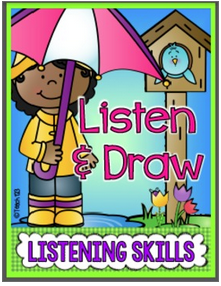Many children enter kindergarten familiar with rhyming words thanks to parents who have read nursery rhymes or books by Dr. Seuss. Parents are their child's first teacher. Identifying and producing rhyming words is an important phonemic awareness skill. Research has also shown the importance of this.
"Correlational studies have identified phonemic awareness and letter knowledge as the two best school entry predictors of how well children will learn to read during their first two years in school."
You can easily incorporate a quick phonemic awareness (P.A.) activity with the Rhyme Climb mat above.
When you meet with your reading group, have your students write the word family that you are focusing on the top line. Students will:
Write words in the word family.
Circle the word family.
To differentiate for your higher readers, encourage them to use blends, digraphs, or write multi syllable words.
Get the wiggles out with movement with stomp & clap. Students clap and make the sound of each consonant and stomp for the vowels.
You can use the mats with your Guided Reading group or add it to a word work center. Laminate it or put it in a dry erase pocket. I found the dry erase pocket at the Target Dollar Spot.
After your small group lesson, give your students additional practice with the printables like the one in the picture above. This is a good way to assess what you taught during your small group lesson plus it holds them accountable.
The answer keys are included so you use this as a self-checking center. You can also use these assignments as seat work or homework.
Does your class have a wide variety of levels this year? Use these differentiation cards to give additional tasks for the Rhyme Climb assignment. I wrote about my differentiation card system HERE. You can read about the system and pick up a freebie, too.
Students can practice their writing skills with the pencil book assignments. This is an open-ended assigned so you can use the assignment to fit your students’ needs. A few suggestions:
•Write sentences using words from the ladder assignment. Underline the words.
•Read “Hey, Little Ant” to your class. Have your students write about what happened in the beginning, middle, and end of the story on the “an” pencil. Highlight all of the words with “an”.
•Brainstorm topics that include the word family on the pencil. Example: Word family –an: pan, Dan, ant, fan
•Write a story about the topic.
•Write 3 sentences describing the topic.
There are two versions, with lines and without lines, so you can differentiate.
Here is a sample of the additional printables included.
Click HERE for a FREEBIE in the preview file.
Looking for more ideas? I have Pinterest boards with games, videos, and other fun stuff.
0
"Correlational studies have identified phonemic awareness and letter knowledge as the two best school entry predictors of how well children will learn to read during their first two years in school."
National Reading Panel: Teaching Children to Read
Page 2-1
You can easily incorporate a quick phonemic awareness (P.A.) activity with the Rhyme Climb mat above.
When you meet with your reading group, have your students write the word family that you are focusing on the top line. Students will:
Write words in the word family.
Circle the word family.
To differentiate for your higher readers, encourage them to use blends, digraphs, or write multi syllable words.
Get the wiggles out with movement with stomp & clap. Students clap and make the sound of each consonant and stomp for the vowels.
You can use the mats with your Guided Reading group or add it to a word work center. Laminate it or put it in a dry erase pocket. I found the dry erase pocket at the Target Dollar Spot.
After your small group lesson, give your students additional practice with the printables like the one in the picture above. This is a good way to assess what you taught during your small group lesson plus it holds them accountable.
The answer keys are included so you use this as a self-checking center. You can also use these assignments as seat work or homework.
Does your class have a wide variety of levels this year? Use these differentiation cards to give additional tasks for the Rhyme Climb assignment. I wrote about my differentiation card system HERE. You can read about the system and pick up a freebie, too.
Students can practice their writing skills with the pencil book assignments. This is an open-ended assigned so you can use the assignment to fit your students’ needs. A few suggestions:
•Write sentences using words from the ladder assignment. Underline the words.
•Read “Hey, Little Ant” to your class. Have your students write about what happened in the beginning, middle, and end of the story on the “an” pencil. Highlight all of the words with “an”.
•Brainstorm topics that include the word family on the pencil. Example: Word family –an: pan, Dan, ant, fan
•Write a story about the topic.
•Write 3 sentences describing the topic.
There are two versions, with lines and without lines, so you can differentiate.
Here is a sample of the additional printables included.
Click HERE for a FREEBIE in the preview file.
Looking for more ideas? I have Pinterest boards with games, videos, and other fun stuff.
Click HERE to read my blog's disclosure statement.































































